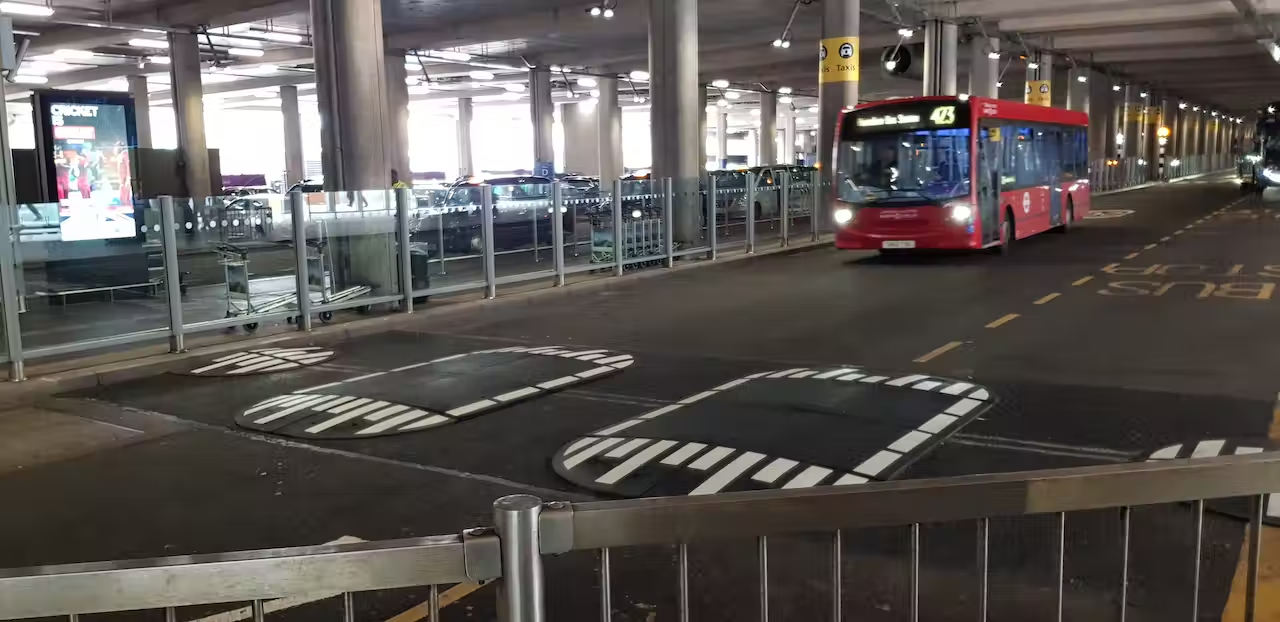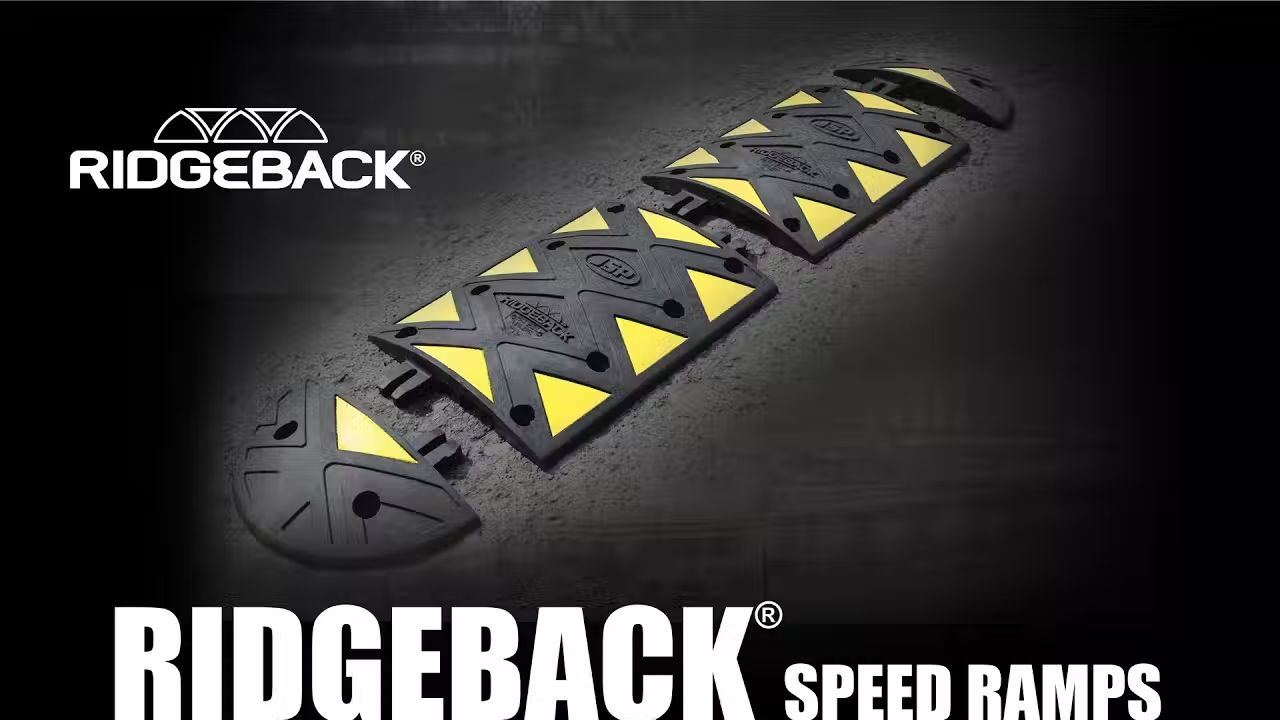How Effective are Speed Bumps at Slowing Vehicle Traffic?
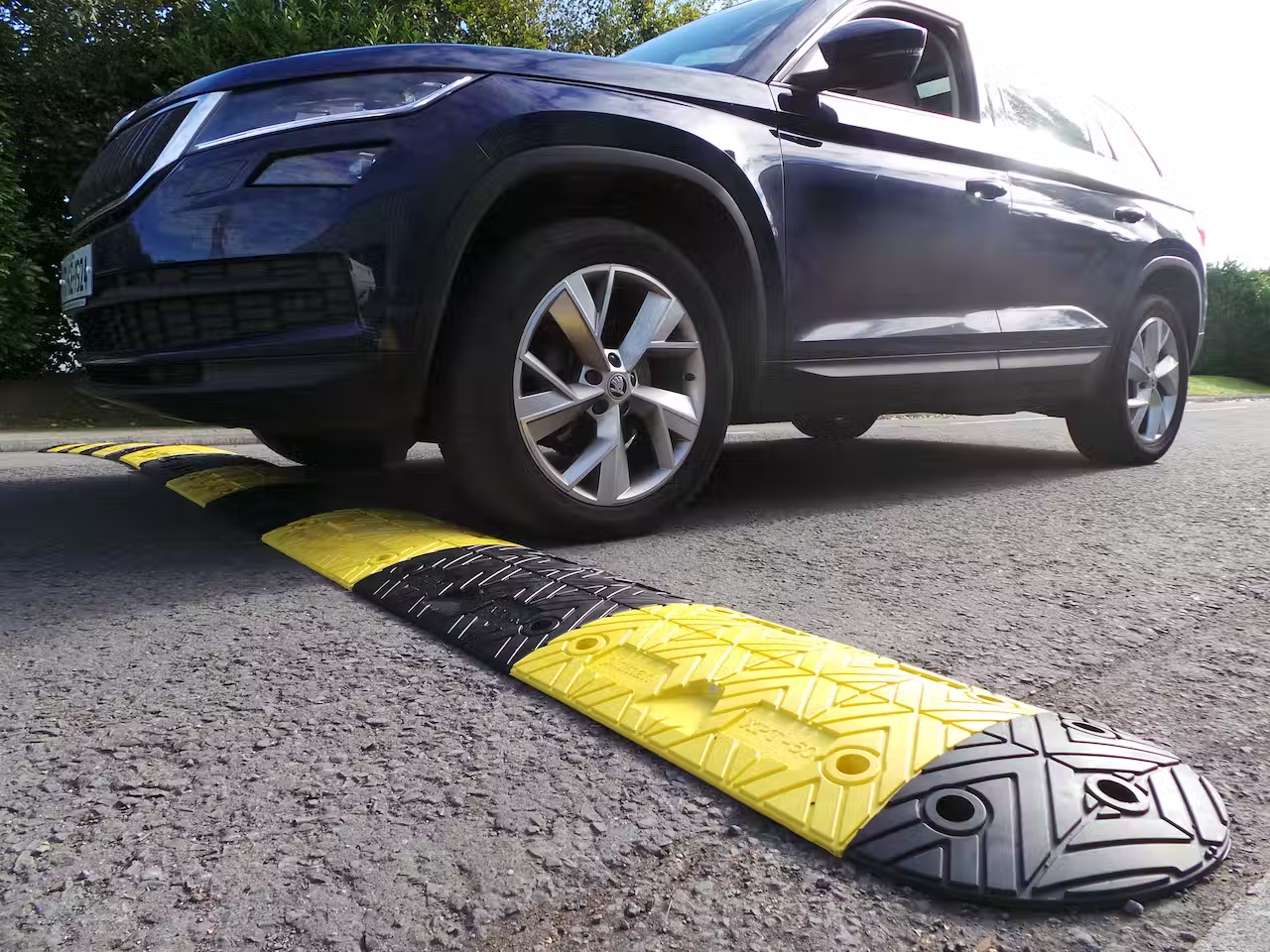
When it comes to slowing vehicles, there is one known fact – speed is the main contributing factor in fatal accidents on roads.
According to the Department of Transport, Local Government and Regions (DTLR) speed is a major contributory factor in around one-third of all road traffic accidents.
In 2020 there were a total of 1,460 road deaths with a reported 115,584 reported casualties of all severities across the UK. While this is a decrease from the figures in 2019 it must be noted that this includes several months of government restrictions and less vehicles on UK roads for certain periods.
Why do accidents occur at speed
If cars are moving faster, there is an increase in the risk of accidents occurring. This is because, at higher speeds, drivers will have less time to react to what is on the road in front of them.
While driving at higher speeds is suitable on motorways or national roads, it isn’t safe or legal on more minor regional or local roads. Therefore, speed needs to be controlled on these roads to uphold road safety and reduce the risk of traffic accidents. Reducing vehicle speed can also significantly improve pedestrian safety at schools, business premises, hospitals, factories and more.
One of the most common ways to significantly reduce vehicle speed is by using traffic calming measures. Traffic calming generally refers to anything used to reduce traffic speeds on public roads. Traffic calming may refer to several measures, including speed bumps, a speed cushion, a speed table, speed humps, road signage, or street furniture. Some traffic calming setups may employ a number of these measures at once, especially where there is an increased danger of accidents.
The benefits of speed bumps
Speed bumps are one of the most effective ways to slow traffic on UK roads and are currently the most popular traffic calming method in the UK. Over 42,000 individual speed bumps are in use across the UK mainland, covering a total distance of 2,000 miles on more than 14,000 roads.
Why is speed bump use so widespread? The statistics speak for themselves. Studies worldwide have shown that speed bump installations can reduce the risk of traffic accidents by approximately 35-40%.
The theory behind it is simple – the immediate bump caused to vehicles will encourage drivers to slow down considerably and reduce overall road speeds. Failing to slow down will result in an uncomfortable drive for drivers. In severe cases, high speeds over the bumps may also damage the driver’s car. The higher the bump, the slower vehicles will need to proceed to get over them safely.
In total, the benefits of speed bumps include:
- Reduction of speed and protection of children and pedestrians – the proposed speed bump will help to lower the speeds of vehicles. At lower speeds, drivers will have better reaction times and children and pedestrians are exposed to less risk.
- Reduction in traffic noise – lowering the vehicle speed will decrease the noise of high revs in the area. Additionally, modern speed cushions and speed tables are made with a highly durable rubber material that helps to lower sound and vibrations.
- A physical effect on the driver – the bump caused to the vehicle is much more effective at alerting drivers, especially when compared to standard road markings or signage. A combination of speed bump, signage and road marking may be the best way to alert the driver.
- Cost-effective installation and maintenance – modern speed bumps come in a modular rubber design. This allows for much easier installation and less time on road closures. The individual sections are also much easier to replace at a lower cost compared to concrete speed bumps.
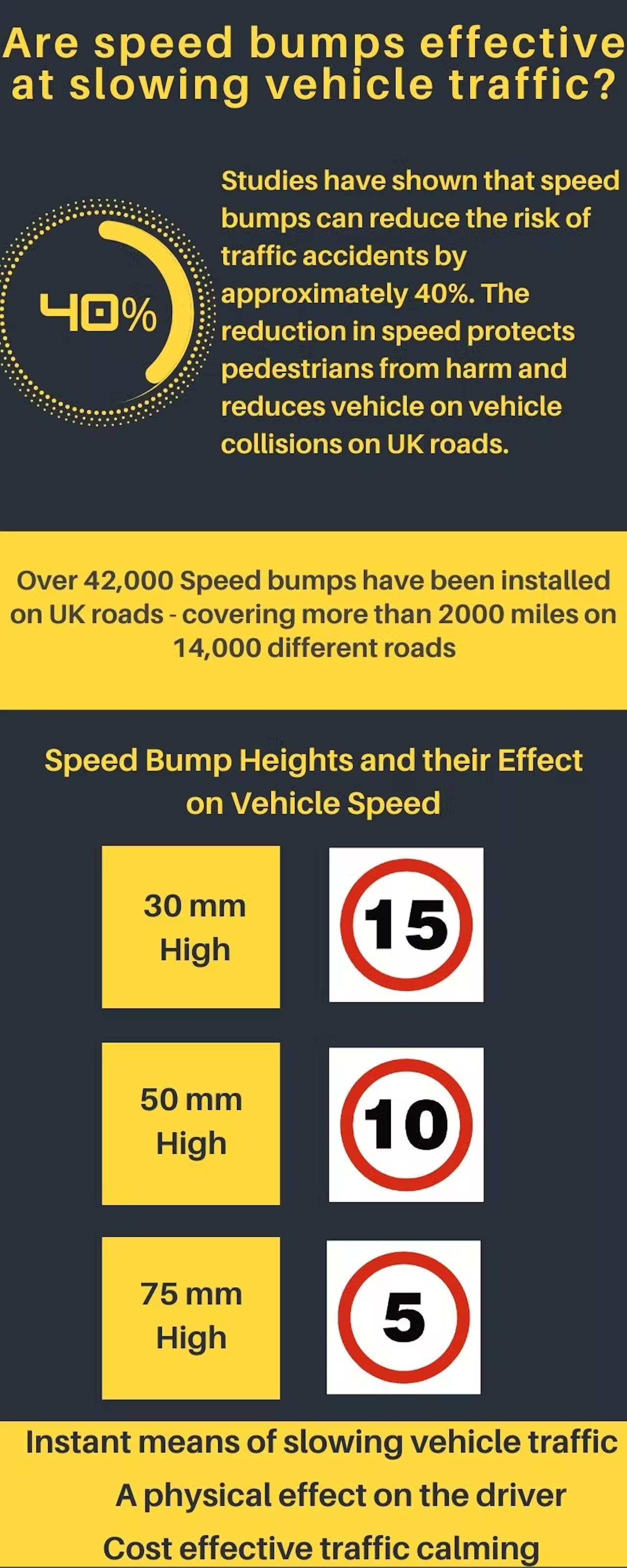
What speed bump heights mean for vehicle speeds
The height of the speed bump will generally determine what speed the driver will have to slow down to avoid an uncomfortable drive. Lower heights will mean higher speeds, while more elevated bumps will mean lower speeds.
50mm high tends to be the go-to option for general car traffic. This height is enough to slow cars to 10mph or less. Severe options, like 75mm high-speed bumps, will slow cars to as low as 5mph. More elevated speed bumps like the 75mm option can reduce speed in areas with immediate danger to pedestrians. However, using them in areas where the traffic needs to flow may cause more of a hindrance than a solution.
Recommended speed bump installation
Generally, multiple speed bumps should be kept at least a vehicles length or more apart on roads. Today’s standard cars work out at approximately 14.7 feet or 4600mm.
The installation of the speed bumps can significantly affect how well they work at slowing vehicles. Therefore, to get the best out of them, installing them in the right areas and in the right way is crucial.
If working with one particular type of vehicle, for example, a truck yard and trucks, this would be approximately the length of an average truck.
This gap allows the vehicle enough time to recover while avoiding it bouncing back and forth from multiple bumps. The smaller the gap, the slower drivers will have to go, which may be suited for housing estates and similar places. Longer intervals may be better suited to public roads or town centres where traffic will keep flowing.
When installing speed bumps, be sure to avoid placing them too close to:
- Junctions – speed bumps that are too close to junctions may effect drivers that are driving too fast on approach to the bump.
- Entrances or exits to a premises – place speed bumps in optimal places so that they can slow traffic before they get to the entrance or exit
- Bends and corners – most speed bumps are designed to be installed in a 180 degree manner. If drivers are turning while moving over the speed bump they may risk the car sliding or damaging the speed bump.
- Pedestrian crossings – avoid putting standard speed bumps directly beside crossings. Again, place it further back to encourage drivers to slow before the reach the crossing. Some speed table systems can be used as a traffic calming and pedestrian crossing system in one.
Speed humps for emergency vehicles
Emergency vehicles can be significantly affected by speed bump placements. Traffic calming systems provide increased safety, but they can ironically slow emergency vehicles and hinder response times.
Responding to emergency calls quickly can mean the difference between life and death in some circumstances.
Speed humps, similar to speed bumps, slow vehicle traffic but work differently. A speed hump is longer from front to back and provides a gentle curve or bump instead of an immediate bump. The design of a speed hump allows traffic to flow smoothly without slowing the vehicle to a near stop.
Speed humps are typical in towns or cities where traffic needs to remain flowing at a reasonable speed.
There are two key ways to install speed humps to help emergency vehicle response.
- An offset layout of the speed humps can also improve response times for emergency vehicles. By installing the humps in a staggered manner in opposite lanes, these larger vehicles can drive around them without touching the hump.
- A side-by-side layout will allow the emergency vehicle’s larger axles to fit around the speed hump and continue unimpaired.
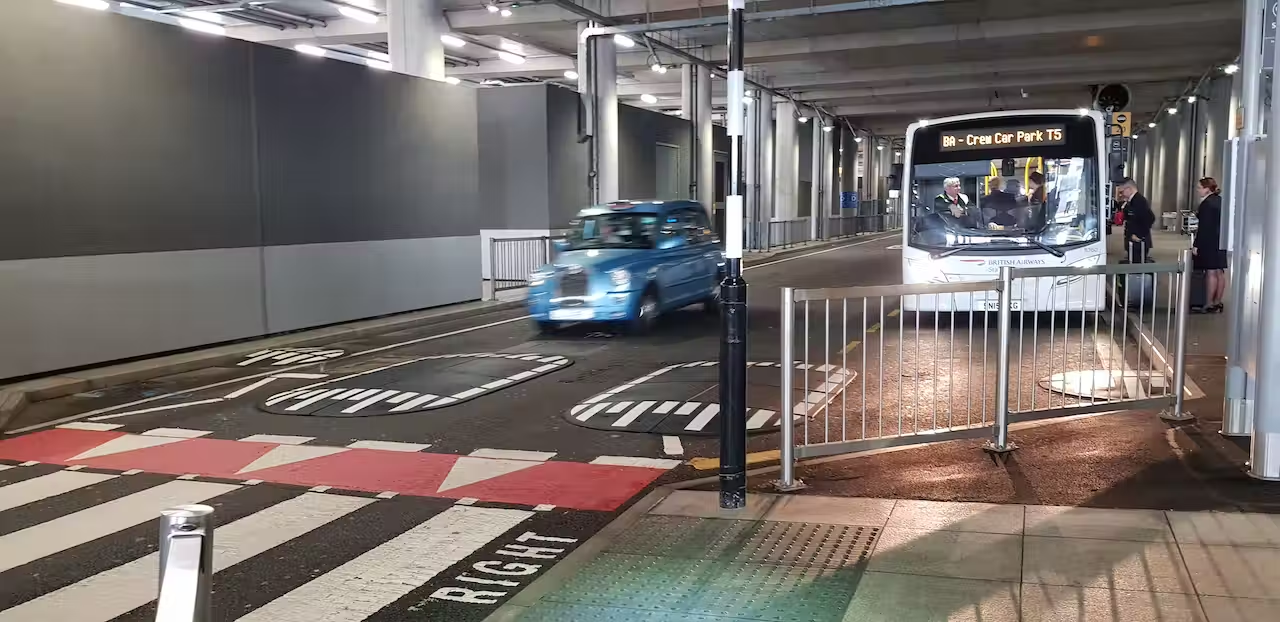
Advantages of modular rubber speed bumps
Modular rubber speed bumps provide an effective traffic calming solution at a lower cost. There are several key advantages in choosing rubber over concrete speed bumps.
- Easier, faster installation and reduced disruptions to roads
- Minimal maintenance required while in use
- Easily replace individual sections if damaged
- Cost-effective and cheaper to buy or replace
- Increased visibility with integral reflective markings
- Made from recycled materials, which reduce the carbon footprint
- Less damaging to vehicles during speeding
Modular rubber speed bumps are have become staple traffic calming measures on UK roads. Most local authorities have opted for concrete or tarmac for various reasons in the past. However, concrete or tarmac speed humps come with several drawbacks.
Firstly, concrete is much more challenging to install and shape on roads. The labour effort required for installation will result in more prolonged road closures and longer installation times.
Secondly, concrete and tarmac are prone to breaking after long term use. Broken sections can damage vehicles and increase wear and tear if not looked after.
Lastly, they are much more expensive to install and maintain over time, between labour and product costs.
Speed bumps have proven to be the most effective way to slow speeding vehicles and continue to be used every day across the UK. While some drivers see them as a problem, they have greatly helped and will continue to help reduce traffic accidents for the foreseeable future.
